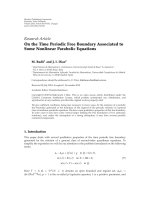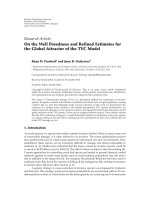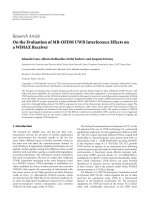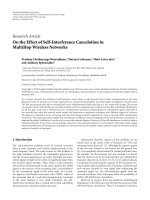Báo cáo hóa học: " Research Article On the Stability of Quadratic Double Centralizers and Quadratic Multipliers: A Fixed Point Approach" potx
Bạn đang xem bản rút gọn của tài liệu. Xem và tải ngay bản đầy đủ của tài liệu tại đây (484.51 KB, 9 trang )
Hindawi Publishing Corporation
Journal of Inequalities and Applications
Volume 2011, Article ID 957541, 9 pages
doi:10.1155/2011/957541
Research Article
On the Stability of Quadratic Double Centralizers
and Quadratic Multipliers: A Fixed Point Approach
Abasalt Bodaghi,
1
Idham Arif Alias,
2
and Madjid Eshaghi Gordji
3
1
Department of Mathematics, Garmsar Branch, Islamic Azad University, Garmsar, Iran
2
Laboratory of Theoretical Studies, Institute for Mathematical Research, University Putra Malaysia UPM,
43400 Serdang, Selangor Darul Ehsan, Malaysia
3
Department of Mathematics, Semnan University, P.O. Box 35195-363, Semnan, Iran
Correspondence should be addressed to Abasalt Bodaghi,
Received 3 December 2010; Revised 11 January 2011; Accepted 18 January 2011
Academic Editor: Michel Chipot
Copyright q 2011 Abasalt Bodaghi et al. This is an open access article distributed under the
Creative Commons Attribution License, which permits unrestricted use, distribution, and
reproduction in any medium, provided the original work is properly cited.
We prove the superstability of quadratic double centralizers and of quadratic multipliers on
Banach algebras by fixed point methods. These results show that we can remove the conditions
of being weakly commutative and weakly without order which are used in the work of M. E.
Gordji et al. 2011 for Banach algebras.
1. Introduction
In 1940, Ulam 1 raised the following question concerning stability of group homomor-
phisms: under what condition does there exist an additive mapping near an approximately additive
mapping? Hyers 2 answered the problem of Ulam for Banach spaces. He showed that for
two Banach spaces X and Y,if>0andf : X→Ysuch that
f
x y
− f
x
− f
y
≤ , 1.1
for all x, y ∈X, then there exist a unique additive mapping T : X→Ysuch that
f
x
− T
x
≤ ,
x ∈X
. 1.2
2 Journal of Inequalities and Applications
The work has been extended to quadratic functional equations. Consider f : X→Yto be
a mapping such that ftx is continuous in t ∈ R, for all x ∈X. Assume that there exist
constants ≥ 0andp ∈ 0, 1 such that
f
x y
− f
x
− f
y
≤
x
p
y
p
,
x ∈X
.
1.3
Th. M. Rassias in 3 showed with the above conditions for f, there exists a unique R-linear
mapping T : X→Ysuch that
f
x
− T
x
≤
2
2 − 2
p
x
p
,
x ∈X
.
1.4
G
˘
avrut¸a then generalized the Rassias’s result in 4.
A square norm on an inner product space satisfies the important parallelogram
equality
x y
2
x − y
2
2
x
2
y
2
. 1.5
Recall that t he functional equation
f
x y
f
x − y
2f
x
2f
y
1.6
is called quadratic functional equation. In addition, every solution of functional eqaution
1.6 is said to be a quadratic mapping. A Hyers-Ulam stability problem for the quadratic
functional equation was proved by Skof 5 for mappings f : X→Y, where X is a normed
space and Y is a Banach space. Cholewa 6 noticed that the theorem of Skof is still true
if the relevant domain X is replaced by an abelian group. Indeed, Czerwik in 7 proved
the Cauchy-Rassias stability of the quadratic functional equation. Since then, the stability
problems of various functional equation have been extensively investigated by a number of
authors e.g, 8–13.
One should remember that the functional equation is called stable if any approximately
solution to the functional equation is near to a true solution of that functional equation, and is
super superstable if every approximately solution is an exact solution of it see 14. Recently,
the first and third authors in 15 investigated the stability of quadratic double centralizer:
the maps which are quadratic and double centralizer. Later, Eshaghi Gordji et al. introduced
a new concept of the quadratic double centralizer and the quadratic multipliers in 16,and
established the stability of quadratic double centralizer and quadratic multipliers on Banach
algebras. They also established the superstability for those which are weakly commutative
and weakly without order. In this paper, we show that the hypothesis on Banach algebras
being weakly commutative and weakly without order in 16 can be eliminated, and prove
the superstability of quadratic double centralizers and quadratic multipliers on a Banach
algebra by a method of fixed point.
Journal of Inequalities and Applications 3
2. Stability of Quadratic Double Centralizers
A linear mapping L : A→Ais said to be left centralizer on A if LabLab, for all a, b ∈A.
Similarly, a linear mapping R : A→Asatisfying RabaRb, for all a, b ∈Ais called
right centralizer on A.Adouble centralizer on A is a pair L, R, where L is a left centralizer, R
is a right centralizer and aLbRab, for all a, b ∈A. An operator T : A→Ais said to be
a multiplier if aTbTab, for all a, b ∈A.
Throughout this paper, let A be a complex Banach algebra. Recall that a mapping
L : A→Ais a quadratic left centralizer if L is a quadratic homogeneous mapping, that is L
is quadratic and L
λaλ
2
La, for all a ∈Aand λ ∈ C,andLabLab
2
, for all a, b ∈A.
A mapping R : A→Ais a quadratic right centralizer if R is a quadratic homogeneous
mapping and Raba
2
Rb, for all a, b ∈A. Also, a quadratic double centralizer of
an algebra A is a pair L, R where L is a quadratic left centralizer, R is a quadratic right
centralizer and a
2
LbRab
2
, for all a, b ∈Asee 16 for details.
It is proven in 8; that for the vector spaces X and Y and the fixed positive integer k,
the map f : X→Yis quadratic if and only if the following equality holds:
2f
kx ky
2
2f
kx − ky
2
k
2
f
x
k
2
f
y
.
2.1
We thus can show that f is quadratic if and only if for a fixed positive integer k, the following
equality holds:
f
kx ky
f
kx − ky
2k
2
f
x
2k
2
f
y
.
2.2
Before proceeding to the main results, we will state the following theorem which is useful to
our purpose.
Theorem 2.1 The alternative of fixed point 17. Suppose t hat we are given a complete
generalized metric space X, d and a strictly contractive mapping T : X → X with Lipschitz
constant L. Then for each given x ∈ X,eitherdT
n
x, T
n1
x∞, for all n ≥ 0, or else exists a
natural number n
0
such that
1 dT
n
x, T
n1
x < ∞, for all n ≥ n
0
,
2 the sequence {T
n
x} is convergent to a fixed point y
∗
of T,
3 y
∗
is the unique fixed point of T in the set Λ{y ∈ X : dT
n
0
x, y < ∞},
4 dy, y
∗
≤ 1/1 − Ldy, Ty, for all y ∈ Λ.
Theorem 2.2. Let f
j
: A→Abe continuous mappings with f
j
00 (j 0, 1), and let φ : A
6
→
0, ∞ be continuous in the first and second variables such that
f
j
λa λb cd
f
j
λa − λb cd
− 2λ
2
f
j
a
f
j
b
−2
1 − j
f
j
c
d
2
1−j
j
c
2
f
j
d
j
u
2
f
0
v
− f
1
u
v
2
≤
a, b, c, d, u, v
,
2.3
4 Journal of Inequalities and Applications
for all λ ∈ T {λ ∈ C : |λ| 1} and, for all a, b,c, d,u, v ∈A,j 0, 1. If there exists a constant m,
0 <m<1 such that
φ
a, b, c, d, u, v
≤ 4m Min
φ
a
2
,
b
2
,
c
2
,d,
u
2
,
v
2
,φ
a
2
,
b
2
,c,
d
2
,
u
2
,
v
2
, 2.4
for all a, b, c, d, u, v ∈A, then there exists a unique double quadratic centralizer L, R on A
satisfying
f
0
a
− L
a
≤
1
4
1 − m
φ
a, a, 0, 0, 0, 0
,
2.5
f
1
a
− R
a
≤
1
4
1 − m
φ
a, a, 0, 0, 0, 0
,
2.6
for all a ∈A.
Proof. From 2.4, it follows that
lim
i
4
−i
φ
2
i
a, 2
i
b, 2
i
c, d,2
i
u, 2
i
v
0,
2.7
for all a, b,c, d,u, v ∈A. Putting j 0,λ 1,a b, c d u v 0 and replacing a by 2a
in 2.3,weget
f
0
2a
− 4f
0
a
≤ φ
a, a, 0, 0, 0, 0
, 2.8
for all a ∈A. By the above inequality, we have
1
4
f
0
2a
− f
0
a
≤
1
4
φ
a, a, 0, 0, 0, 0
, 2.9
for all a ∈A. Consider the set X : {g : A→A|g00} and introduce the generalized
metric on X:
d
h, g
: inf
C ∈ R
:
g
a
− h
a
≤ Cφ
a, a, 0, 0, 0, 0
, ∀a ∈A
. 2.10
It is easy to show that X, d is complete. Now, we define the linear mapping Q : X → X by
Q
h
a
1
4
h
2a
, 2.11
for all a ∈A.Giveng,h ∈ X,letC ∈ R
be an arbitrary constant with dg,h ≤ C,thatis
g
a
− h
a
≤ Cφ
a, a, 0, 0, 0, 0
, 2.12
Journal of Inequalities and Applications 5
for all a ∈A. Substituting a by 2a in the inequality 2.12 and using 2.4 and 2.11, we have
Qg
a
−
Qh
a
1
4
g
2a
− h
2a
≤
1
4
Cφ
2a, 2a, 0, 0, 0, 0
≤ Cmφ
a, a, 0, 0, 0, 0
,
2.13
for all a ∈A. Hence, dQg, Qh ≤ Cm. Therefore, we conclude that dQg, Qh ≤ mdg,h,
for all g, h ∈ X. It follows from 2.9 that
d
Qf
0
,f
0
≤
1
4
.
2.14
By Theorem 2.1, Q has a unique fixed point L : A→Ain the set X
1
{h ∈
X, df
0
,h < ∞}. On the other hand,
lim
n →∞
f
0
2
n
a
4
n
L
a
,
2.15
for all a ∈A.ByTheorem 2.1 and 2.14,weobtain
d
f
0
,L
≤
1
1 − m
d
Qf
0
,L
≤
1
4
1 − m
, 2.16
that is, the inequality 2.5 is true, for all a ∈A. Now, substitute 2
n
a and 2
n
b by a and b
respectively, put c d u v 0andj 0in2.15. Dividing both sides of the resulting
inequality by 2
n
, and letting n goes to infinity, it follows from 2.7 and 2.3 that
L
λa λb
L
λa − λb
2λ
2
L
a
2λ
2
L
b
,
2.17
for all a, b ∈Aand λ ∈ T. Putting λ 1in2.17 we have
L
a b
L
a − b
2L
a
2L
b
, 2.18
for all a, b ∈A. Hence L is a quadratic mapping.
Letting b 0in2.17,wegetLλaλ
2
La, for all a, b ∈Aand λ ∈ T. We can show
from 2.18 that Lrar
2
La for any rational number r. It follows from the continuity of f
0
and φ that for each λ ∈ R, Lλaλ
2
La.So,
L
λa
L
λ
|
λ
|
|
λ
|
a
λ
2
|
λ
|
2
L
|
λ
|
a
λ
2
|
λ
|
2
|
λ
|
2
L
a
λ
2
L
a
,
2.19
6 Journal of Inequalities and Applications
for all a ∈Aand λ ∈ Cλ
/
0. T herefore, L is quadratic homogeneous. Putting j 0, a b
u v 0in2.3 and replacing 2
n
c by c,weobtain
f
0
2
n
cd
4
n
−
f
0
2
n
c
4
n
d
2
≤
1
2
4
−n
φ
0, 0, 2
n
c, d,0, 0
.
2.20
By 2.7, the right hand side of t he above inequality tends to zero as n →∞. It follows from
2.15 that LcdLcd
2
, for all c, d ∈A. Therefore L is a quadratic left centralizer. Also,
one can show that there exists a unique mapping R : A→Awhich satisfies
lim
n →∞
f
1
2
n
a
4
n
R
a
,
2.21
for all a ∈A. The same manner could be used to show that R is a quadratic right centralizer.
If we substitute u and v by 2
n
u and 2
n
v in 2.3 respectively, and put a b c d 0, and
divide both sides of the obtained inequality by 8
n
, then we get
u
2
f
0
2
n
v
2
n
−
f
1
2
n
u
2
n
v
2
≤ 8
−n
φ
0, 0, 0, 0, 2
n
u, 2
n
v
.
2.22
Passing to the limit as n →∞, and again from 2.7, we conclude that u
2
LvRuv
2
,for
all u, v ∈A. Therefore L, R is a quadratic double centralizer on A. This completes the proof
of this theorem.
Now, we establish the superstability of double quadratic centralizers on Banach
algebras as follows.
Corollary 2.3. Let 0 <m<1,p<2 with 2
p−2
≤ m,letf
j
: A→Abe continuous mappings with
f
j
00 (j 0, 1), and let
f
j
λa λb cd
f
j
λa − λb cd
− 2λ
2
f
j
a
f
j
b
− 2
1 − j
f
j
c
d
2
1−j
j
c
2
f
j
d
j
u
2
f
0
v
− f
1
u
v
2
≤
a
p
b
p
c
p
u
p
v
p
d
p
,
2.23
for all λ ∈ T {λ ∈ C : |λ| 1} and, for all a, b, c,d, u, v ∈A,j 0, 1.Thenf
0
,f
1
is a double
quadratic centralizer on A.
Proof. The result follows from Theorem 2.2 by putting φa, b, c, d, u, va
p
b
p
c
p
u
p
v
p
d
p
.
Journal of Inequalities and Applications 7
3. Stability of Quadratic Multipliers
Assume that A is a complex Banach algebra. Recall that a mapping T : A→Ais a quadratic
multiplier if T is a quadratic homogeneous mapping, and a
2
TbTab
2
, for all a, b ∈Asee
16. We investigate the stability of quadratic multipliers.
Theorem 3.1. Let f : A→Abe a continuous mapping with f00 and let φ : A
4
→ 0, ∞ be
a function which is continuous in the first and second variables such that
f
λa λb
f
λa − λb
− 2λ
2
f
a
f
b
c
2
f
d
− f
c
d
2
≤ φ
a, b, c, d
, 3.1
for all λ ∈ T and all a, b, c, d ∈A. Suppose exists a constant m, 0 <m<1, such that
φ
2a, 2b, 2c, 2d
≤ 4mφ
a, b, c, d
, 3.2
for all a, b, c, d ∈A. Then there exists a unique multiplier T on A satisfying
f
a
− T
a
≤
1
4
1 − m
φ
a, a, 0, 0
,
3.3
for all a ∈A.
Proof. It follows from 3.2 that
lim
n →∞
φ
2
n
a, 2
n
b, 2
n
c, 2
n
d
4
n
0,
3.4
for all a, b, c, d ∈A. Putting λ 1, a b, c d 0in3.1,weobtain
f
2a
− 4f
a
≤ φ
a, a, 0, 0
, 3.5
for all a ∈A.Thus
f
a
−
1
4
f
2a
≤
1
4
φ
a, a, 0, 0
, 3.6
for all a ∈A.NowwesetX : {h : A→A|h00} and introduce the generalized metric
on X as
d
g,h
: inf
C ∈ R
:
g
a
− h
a
≤ Cφ
a, a, 0, 0
, ∀a ∈A
. 3.7
It is easy to show that X, d is complete. Consider the mapping Φ : X → X defined by
Φha1/4h2a, for all a ∈A. By the same reasoning as in the proof of Theorem 2.2, Φ is
strictly contractive on X. It follows from 3.6 that dΦf, f ≤ 1/4.ByTheorem 2.1, Φ has a
unique fixed point in the set X
1
: {h ∈ X : df, h < ∞}.LetT be the fixed point of Φ. Then
8 Journal of Inequalities and Applications
T is the unique mapping with T2a4Ta, for all a ∈Asuch that there exists C ∈ 0, ∞
satisfying
T
x
− f
x
≤ Cφ
a, a, 0, 0
, 3.8
for all a ∈A. On the other hand, we have lim
n →∞
dΦ
n
f,T0. Thus
lim
n →∞
1
4
n
f
2
n
x
T
x
,
3.9
for all a ∈A. Hence
d
f, T
≤
1
1 − m
d
T, Φ
f
≤
1
4
1 − m
.
3.10
This implies the inequality 3.3. It follows from 3.1, 3.4 and 3.9 that
T
λa λb
T
λa − λb
− 2λ
2
T
a
− 2λ
2
T
b
lim
n →∞
1
4
n
T
2
n
λa λb
T
2
n
λa − λb
− 2λ
2
T
2
n
a
− 2λ
2
T
2
n
b
≤ lim
n →∞
1
4
n
φ
2
n
a, 2
n
b, 0, 0
0,
3.11
for all a, b ∈A.Thus
L
λa λb
L
λa − λb
2λ
2
L
a
2λ
2
L
b
,
3.12
for all a, b ∈Aand λ ∈ T. Letting b 0in3.14, we have Lλaλ
2
La, for all a, b ∈A
and λ ∈ T. Now, it follows from the proof of Theorem 2.1 and continuity of f and φ that T is
C-linear. If we substitute c and d by 2
n
c and 2
n
d in 3.1, respectively, and put a b 0and
we divide the both sides of the obtained inequality by 8
n
,weget
c
2
f
2
n
d
4
n
−
f
2
n
c
4
n
d
2
≤
φ
0, 0, 2
n
c, 2
n
d
8
n
.
3.13
Passing to the limit as n →∞,andfrom3.4 we conclude that c
2
TdTcd
2
, for all
c, d ∈A.
Using Theorem 3.1, we establish the superstability of quadratic multipliers on Banach
algebras.
Journal of Inequalities and Applications 9
Corollary 3.2. Let 0 <m<1,p<2/3 with 2
3p−2
≤ m, and f : A→Abe a continuous mapping
with f00, and let
f
λa λb
f
λa − λb
− 2λ
2
f
a
f
b
c
2
f
d
− f
c
d
2
≤
a
p
ab
p
c
p
d
p
,
3.14
for all λ ∈ T {λ ∈ C : |λ| 1} and, for all a, b, c, d ∈A.Thenf is a quadratic multiplier on A.
Proof. The results follows from Theorem 3.1 by putting φa, b, c, da
p
b
p
c
p
d
p
.
References
1 S. M. Ulam, Problems in Modern Mathematics, chapter VI, John Wiley & Sons, New York, NY, USA,
Science edition, 1940.
2 D. H. Hyers, “On the stability of the linear functional equation,” Proceedings of the National Academy of
Sciences of the United States of America, vol. 27, pp. 222–224, 1941.
3 Th. M. Rassias, “On the stability of the linear mapping in Banach spaces,” Proceedings of the American
Mathematical Society, vol. 72, no. 2, pp. 297–300, 1978.
4 P. G
˘
avrut¸a, “A generalization of the Hyers-Ulam-Rassias stability of approximately additive
mappings,” Journal of Mathematical Analysis and Applications, vol. 184, no. 3, pp. 431–436, 1994.
5 F. Skof, “Proprieta’ locali e approssimazione di operatori,” Rendiconti del Seminario Matematico e Fisico
di Milano, vol. 53, pp. 113–129, 1983.
6 P. W. Cholewa, “Remarks on the stability of functional equations,” Aequationes Mathematicae, vol. 27,
no. 1-2, pp. 76–86, 1984.
7 S. Czerwik, “On the stability of the quadratic mapping in normed spaces,” Abhandlungen aus dem
Mathematischen Seminar der Universit
¨
at Hamburg, vol. 62, pp. 59–64, 1992.
8 M. Eshaghi Gordji and A. Bodaghi, “On the Hyers-Ulam-Rassias stability problem for quadratic
functional equations,” East Journal on Approximations, vol. 16, no. 2, pp. 123–130, 2010.
9 M. Eshaghi Gordji and M. S. Moslehian, “A trick for investigation of approximate derivations,”
Mathematical Communications, vol. 15, no. 1, pp. 99–105, 2010.
10 M. Eshaghi Gordji, J. M. Rassias, and N. Ghobadipour, “Generalized Hyers-Ulam stability of
generalized N, K-derivations,” Abstract and Applied Analysis, vol. 2009, Article ID 437931, 8 pages,
2009.
11 M. Eshaghi Gordji and H. Khodaei, “Solution and stability of generalized mixed type cubic, quadratic
and additive functional equation in quasi-Banach spaces,” Nonlinear Analysis: Theory, Methods &
Applications, vol. 71, no. 11, pp. 5629–5643, 2009.
12 P. Kannappan, “Quadratic functional equation and inner product spaces,” Results in Mathematics, vol.
27, no. 3-4, pp. 368–372, 1995.
13 J. R. Lee, J. S. An, and C. Park, “On the stability of quadratic functional equations,” Abstract and Applied
Analysis, vol. 2008, Article ID 628178, 8 pages, 2008.
14 J. A. Baker, “The stability of the cosine equation,” Proceedings of the American Mathematical Society, vol.
80, no. 3, pp. 411–416, 1980.
15 M. Eshaghi Gordji and A. Bodaghi, “On the stability of quadratic double centralizers on Banach
algebras,” Journal of Computational Analysis and Applications, vol. 13, no. 4, pp. 724–729, 2011.
16 M. Eshaghi Gordji, M. Ramezani, A. Ebadian, and C. Park, “Quadratic double centralizers and
quadratic multipliers,” Annali dell’Universit
`
a di Ferrara. In press.
17 J. B. Diaz and B. Margolis, “A fixed point theorem of the alternative for contractions on a generalized
complete metric space,” Bulletin of the American Mathematical Society, vol. 74, pp. 305–309, 1968.









